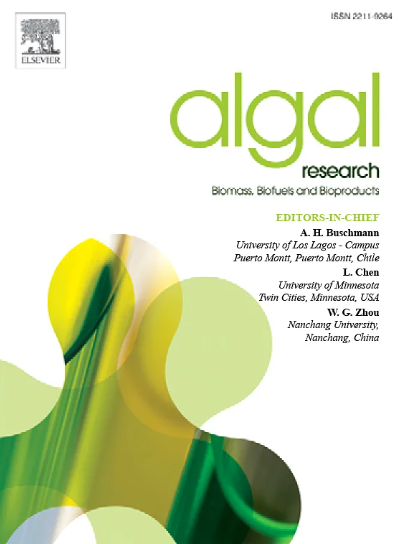Comparative analysis of the of red seaweed polysaccharides on hypertension–associated biomarkers in cadmium chloride-induced Wistar rats
IF 4.6
2区 生物学
Q1 BIOTECHNOLOGY & APPLIED MICROBIOLOGY
Algal Research-Biomass Biofuels and Bioproducts
Pub Date : 2025-03-28
DOI:10.1016/j.algal.2025.104021
引用次数: 0
Abstract
Red seaweeds, recognized for their diverse polysaccharide structures, exhibit significant therapeutic potential in modulating the renin-angiotensin-aldosterone system (RAAS) to mitigate hypertension, a major risk factor for cardiovascular diseases. This study investigates the antihypertensive properties of polysaccharides extracted from four Rhodophyta species: Gracilaria salicornia (GSP), Gracilaria edulis (GEP), Gelidiella acerosa (GAP), and Gelidium pusillum (GPP), using a cadmium chloride (CdCl₂)-induced hypertensive model in Wistar rats. GSP (100 mg/kg BW) significantly reduced hypertension-associated biomarkers, including angiotensin II (>65 %), C-reactive protein and myoglobin (>54 %), and troponin I and T (∼72 %), compared to GEP, GAP, and GPP in hypertensive rats (p < 0.05). GSP also improved serum levels of vitamin E (0.15 μg/mL) and nitric oxide (7.31 μg/mL), comparable to the telmisartan group, which restored vitamin E and nitric oxide to 0.24 μg/mL and 8.27 μg/mL, respectively. Antioxidant assays revealed a significant reduction in enzymatic antioxidant activity in CdCl₂-induced hypertensive rats relative to the healthy control group, with notable recovery upon GSP treatment. Histopathological evaluation indicated restored structural integrity of extracellular and cellular components in GSP-treated hypertensive rats, highlighting its potential to alleviate hypertension-induced oxidative stress.

红藻多糖对氯化镉诱导的 Wistar 大鼠高血压相关生物标志物的比较分析
红海藻多糖结构多样,在调节肾素-血管紧张素-醛固酮系统(RAAS)以减轻高血压(心血管疾病的主要危险因素)方面显示出显著的治疗潜力。采用氯化镉(CdCl 2)诱导的Wistar大鼠高血压模型,研究了从四种红藓属植物:水杨葛尾草(Gracilaria salicornia, GSP)、黄葛尾草(Gracilaria edulis, GEP)、青葛尾草(Gelidiella acerosa, GAP)和pusillum Gelidium (GPP)中提取的多糖的降压作用。与GEP、GAP和GPP相比,GSP (100 mg/kg BW)显著降低高血压相关生物标志物,包括血管紧张素II (> 65%)、c反应蛋白和肌红蛋白(> 54%)、肌钙蛋白I和T (> 72%)。0.05)。GSP还提高了血清维生素E (0.15 μg/mL)和一氧化氮(7.31 μg/mL)水平,与替米沙坦组相当,后者分别使维生素E和一氧化氮恢复到0.24 μg/mL和8.27 μg/mL。抗氧化实验显示,与健康对照组相比,CdCl 2诱导的高血压大鼠的酶抗氧化活性显著降低,经GSP治疗后明显恢复。组织病理学评估显示,gsp治疗的高血压大鼠细胞外和细胞成分的结构完整性得到恢复,突出了其减轻高血压诱导的氧化应激的潜力。
本文章由计算机程序翻译,如有差异,请以英文原文为准。
求助全文
约1分钟内获得全文
求助全文
来源期刊

Algal Research-Biomass Biofuels and Bioproducts
BIOTECHNOLOGY & APPLIED MICROBIOLOGY-
CiteScore
9.40
自引率
7.80%
发文量
332
期刊介绍:
Algal Research is an international phycology journal covering all areas of emerging technologies in algae biology, biomass production, cultivation, harvesting, extraction, bioproducts, biorefinery, engineering, and econometrics. Algae is defined to include cyanobacteria, microalgae, and protists and symbionts of interest in biotechnology. The journal publishes original research and reviews for the following scope: algal biology, including but not exclusive to: phylogeny, biodiversity, molecular traits, metabolic regulation, and genetic engineering, algal cultivation, e.g. phototrophic systems, heterotrophic systems, and mixotrophic systems, algal harvesting and extraction systems, biotechnology to convert algal biomass and components into biofuels and bioproducts, e.g., nutraceuticals, pharmaceuticals, animal feed, plastics, etc. algal products and their economic assessment
 求助内容:
求助内容: 应助结果提醒方式:
应助结果提醒方式:


